
Dorado is a constellation in the Southern Sky. It was named in the late 16th century and is now one of the 88 modern constellations. Its name refers to the mahi-mahi, which is known as dorado ("golden") in Spanish, although it has also been depicted as a swordfish. Dorado contains most of the Large Magellanic Cloud, the remainder being in the constellation Mensa. The South Ecliptic pole also lies within this constellation.

NGC 1818 is a young globular cluster in the north-west part of the Large Magellanic Cloud, about 3.2 kpc from the center. It was discovered by Scottish astronomer James Dunlop in 1826, and has since been well studied.

NGC 1872 is an open cluster within the Large Magellanic Cloud in the constellation Dorado. It was discovered by James Dunlop in 1826.
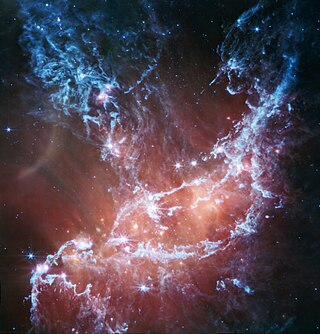
NGC 346 is a young open cluster of stars with associated nebula located in the Small Magellanic Cloud (SMC) that appears in the southern constellation of Tucana. It was discovered August 1, 1826 by Scottish astronomer James Dunlop. J. L. E. Dreyer described it as, "bright, large, very irregular figure, much brighter middle similar to double star, mottled but not resolved". On the outskirts of the cluster is the multiple star system HD 5980, one of the brightest stars in the SMC.
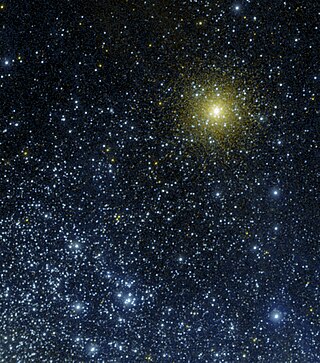
NGC 362 is a globular cluster located in the constellation Tucana in the Southern Hemisphere, slightly north of the Small Magellanic Cloud, to which it is completely unrelated. It was discovered on August 1, 1826 by James Dunlop. It is visible to the naked eye in dark skies, and is an impressive sight in a telescope, although it is somewhat overshadowed by its larger and brighter neighbour 47 Tucanae.

NGC 1806 is a globular cluster located within the Large Magellanic Cloud within the constellation of Dorado, an area of the sky best seen from the Earth's southern hemisphere. It was discovered in 1836 by the British astronomer John Herschel. At an aperture of 50 arcseconds, its apparent V-band magnitude is 11.00, but at this wavelength, it has 0.05 magnitudes of interstellar extinction.
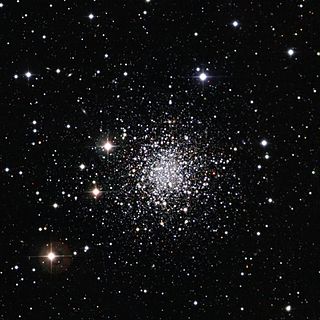
NGC 2257 is a globular cluster that lies on the outskirts of the Large Magellanic Cloud (LMC). It was discovered in 1834 by John Herschel. The compiler of the New General Catalogue, John Louis Emil Dreyer, described this cluster as "faint, considerably large, round, very gradually a little brighter middle, mottled but not resolved, 17.0 seconds of time diameter." At an aperture of 30.5 arcseconds, its apparent V-band magnitude is 12.62, but at this wavelength, it has 0.12 magnitudes of interstellar extinction.
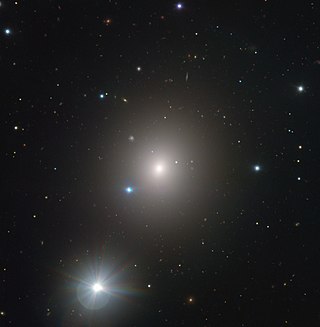
NGC 1404 is an elliptical galaxy in the Southern constellation Eridanus. It was discovered on November 28, 1837, by the astronomer John Herschel. Based on the tip of the red-giant branch distance indicator, it lies at a distance of approximately 60 million light-years from the Milky Way. It is one of the brightest members of the Fornax Cluster.

NGC 1868 is a globular cluster in the Large Magellanic Cloud in the constellation Dorado. It was discovered by John Herschel in 1834. The cluster is fairly metal-poor and as a result appears relatively blue. It maintains an abundant population of mature giant branch stars which have been used to fit its age to roughly 700 million years old. The cluster is located in a relatively sparse region of the Large Magellanic Cloud which has allowed it to be studied relatively free of crowding from background stars.
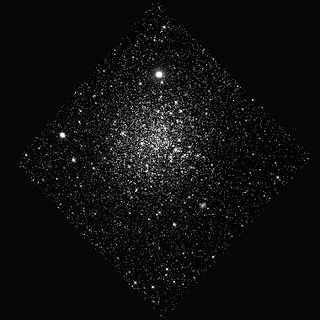
NGC 339 is a globular cluster in the constellation Tucana the Toucan. It is located both visually and physically in the Small Magellanic Cloud, being only about 10,000 ± 12,000 light years closer than the cloud. It is rather prominent, being the brightest cluster in the southern reaches of the cloud. It was discovered by John Herschel on September 18, 1835. It was observed in 2005 by the Hubble Space Telescope. Its apparent V-band magnitude is 12.12, but at this wavelength, it has 0.19 magnitudes of interstellar extinction.

NGC 1783 is a globular cluster within the Dorado constellation and part of the Large Magellanic Cloud, a satellite dwarf galaxy of the Milky Way. At an aperture of 50 arcseconds, its apparent V-band magnitude is 10.39, making it one of the brightest globular clusters in the LMC as viewed from Earth. It was discovered in 1835 by John Herschel. The compiler of the New General Catalogue, John Louis Emil Dreyer, described this cluster as "considerably bright, large, round, very gradually pretty much brighter middle, mottled but not resolved."

NGC 1854 is a young globular cluster in the northern part of the central bar structure of the Large Magellanic Cloud in the Dorado constellation. At 200x magnification the cluster appears very bright, large and round, with dozens of very faint stars visible. NGC 1858, a nebula/star cluster object, lies to the south-east.

NGC 330 is an open cluster in the Small Magellanic Cloud. It is located in the constellation Tucana. It was discovered on 1 August 1826 by James Dunlop. It was described by Dreyer as "a globular cluster, very bright, small, a little extended, stars from 13th to 15th magnitude." At an aperture of 31.0 arcseconds, the apparent V-band magnitude is 9.60, but at this wavelength, it also has 0.36 magnitudes of interstellar extinction.

NGC 1466 is the New General Catalogue designation for a globular cluster in the deep southern constellation of Hydrus. It is located in the outskirts of the Large Magellanic Cloud, which is a satellite galaxy of the Milky Way. The object was discovered November 26, 1834 by English astronomer John Herschel. John Dreyer described it as "pF, pS, iR, glbM, *7 f", meaning "pretty faint, pretty small, irregular round, gradually a little brighter middle, with a 7th magnitude star nearby". When using a small telescope, this is a "faint, small, unresolved and difficult" target with an angular size of 1.9 arc minutes. It has an integrated visual magnitude of 11.4.

NGC 1846 is a globular cluster containing hundreds of thousands of stars in the outer halo of the Large Magellanic Cloud. It was discovered on November 6, 1826, by James Dunlop and is included in the New General Catalogue. At an aperture of 50 arcseconds, its apparent V-band magnitude is 10.68, but at this wavelength, it has 0.07 magnitudes of interstellar extinction.

NGC 411 is a globular cluster located approximately 55,000 pc (180,000 ly) from Earth in the constellation Tucana. It was discovered in 1826 by James Dunlop. It was described by Dreyer as "extremely faint, pretty large, round, gradually very little brighter middle". At a distance of about 180,000 light years (55,000 parsecs), it is located within the Small Magellanic Cloud. It has a mass of about 3.0×104 M☉, and a luminosity of about 8.0×104 L☉.

NGC 419 is a globular cluster located approximately 57,000 pc (190,000 ly) from Earth in the constellation Tucana. It was discovered on September 2, 1826, by James Dunlop. It was described by Dreyer as "pretty large, pretty bright, round, gradually brighter middle". At a distance of about 186,000 light years, it is located within the Small Magellanic Cloud. At an aperture of 50 arcseconds, its apparent V-band magnitude is 10.30, but at this wavelength, it has 0.15 magnitudes of interstellar extinction.
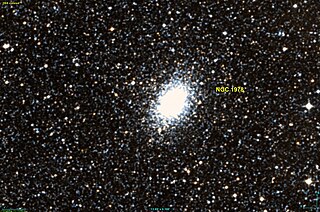
NGC 1978 is an elliptical shaped globular cluster or open cluster in the constellation Dorado. It is located within the Large Magellanic Cloud. It was discovered by James Dunlop on November 6, 1826. At an aperture of 50 arcseconds, its apparent V-band magnitude is 10.20, but at this wavelength, it has 0.16 magnitudes of interstellar extinction. It appears 3.9 arcminutes wide. NGC 1978 has a radial velocity of 293.1 ± 0.9 km/s.

NGC 1866 is a globular cluster in the Large Magellanic Cloud, located in the constellation of Dorado. NGC 1866 was discovered August 3, 1826 by James Dunlop.

NGC 2004 is an open cluster of stars in the southern constellation of Dorado. It was discovered by Scottish astronomer James Dunlop on September 24, 1826. This is a young, massive cluster with an age of about 20 million years and 23,000 times the mass of the Sun. It has a core radius of 2.85 ± 0.46 pc (9.3 ± 1.5 ly). NGC 2004 is a member of the Large Magellanic Cloud, which is a satellite galaxy of the Milky Way.




















